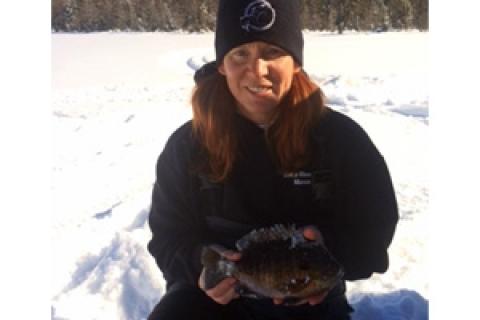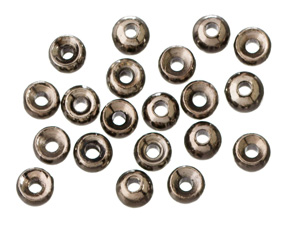
With ice fishing season being in full swing, many fly tiers are feeling the crux of not being able to get out and play with their most recent creations, but this doesn't need to be the case. Although most of the fun with fly fishing is in the presentation of flies to fish, ice fishing with your homemade flies can be rewarding and very effective.
 |
| Tungsten beads work well with ice fly patterns because of their heavy weight for respected size. |
If we look at some of the most popular ice fishing jigs for panfish they basically are constructed with materials that we all use in our favorite nymph patterns. If you like to experiment at your fly tying desk, you will soon find that you can create some super ice patterns that work as good as or better than store bought jigs.
When thinking about tying your own patterns for ice fishing, one of the main concerns that you need to take into consideration is weight. Much like the jigs we use, we want the weight for our fly patterns to be predominately at the hook eye. Tungsten beads are the best choice to use with ice fly patterns as they are very heavy for their respected size. If you do not have any tungsten beads, then regular metallic beads (brass) will work.
If you need more weight for your flies you can always wrap lead free weight onto the hook shank and hide it in the body of the fly. Styles of hooks are the only other structural material that you need to think about. All hooks are not created equal, and the best hooks for ice fly patterns have a large hook gap. Scud hooks or curved shanked nymph hooks are two styles of hooks that work very well for these types of patterns, just make sure that they are constructed with a heavy wire shank.
As you move to selecting materials for your patterns, think about what you are trying to accomplish when the fly is being fished. For tails use marabou, zonker fur or soft plastic, as these materials will move or pulse as the fly is jigged throughout the water column. As you construct the body of the fly, use flashy synthetics — krystal dubbing and tinsels — to give you pattern some flash.
Colors can be just as important as types of materials when tying ice flies, so try and use materials that incorporate white, yellow, chartreuse and red. There are some fly tying materials that are now being constructed with glowing properties and these can be very useful if you are going to be fishing in low light conditions or darker colored waters.
To fish these patterns, simply allow the fly to sink to the desired level and jig it vertically in the water column. With panfish, you should raise and drop the fly three to four inches at a time coupled with intermittent pauses to produce the best results. If the bite really slows, tipping your fly with a waxy or two should liven things up!
This time of year, I am already anticipating a great season on the river, and by using my own flies with ice fishing, it makes this transition of seasons seem that much closer.
- 4993 views

